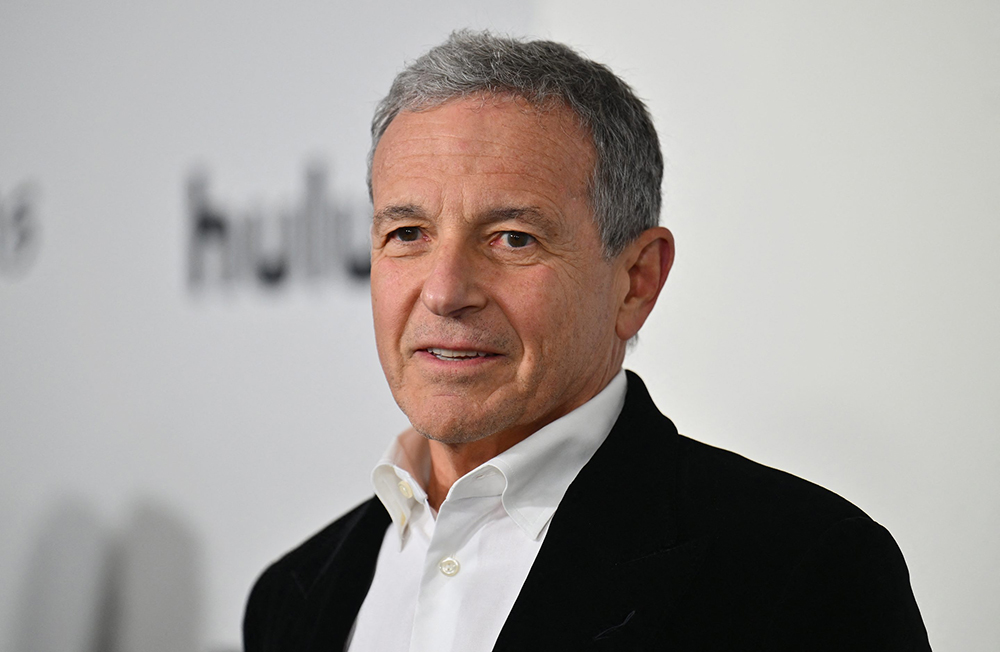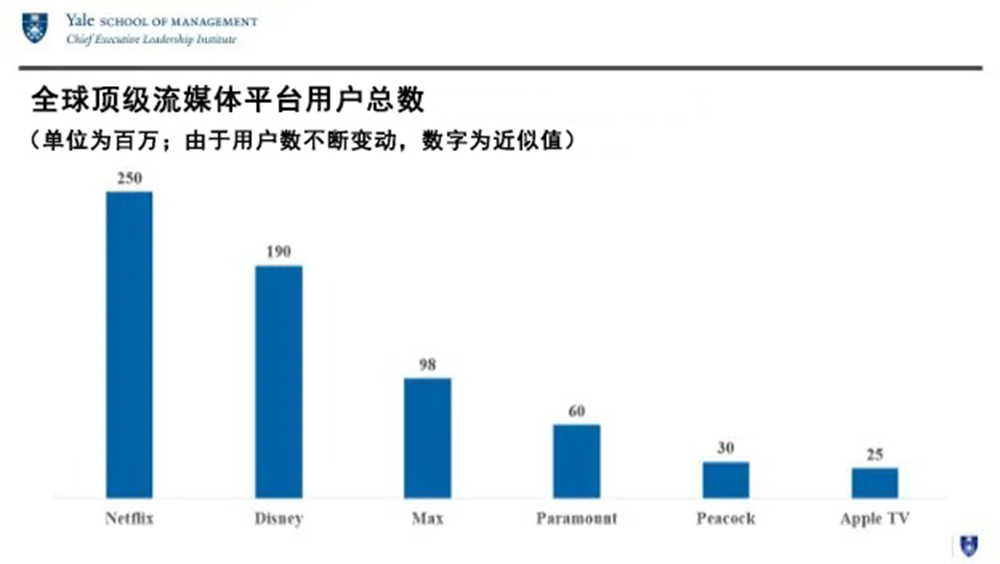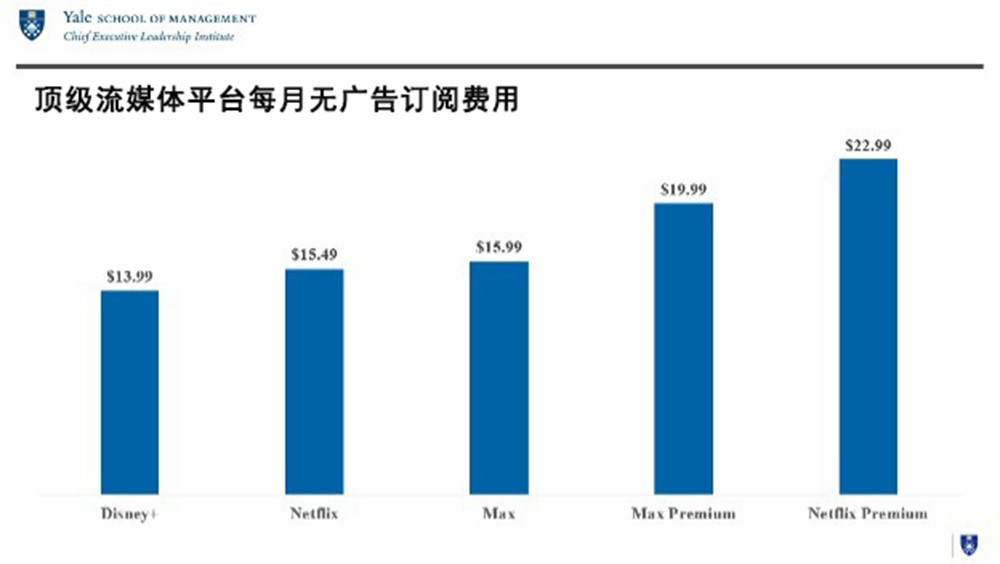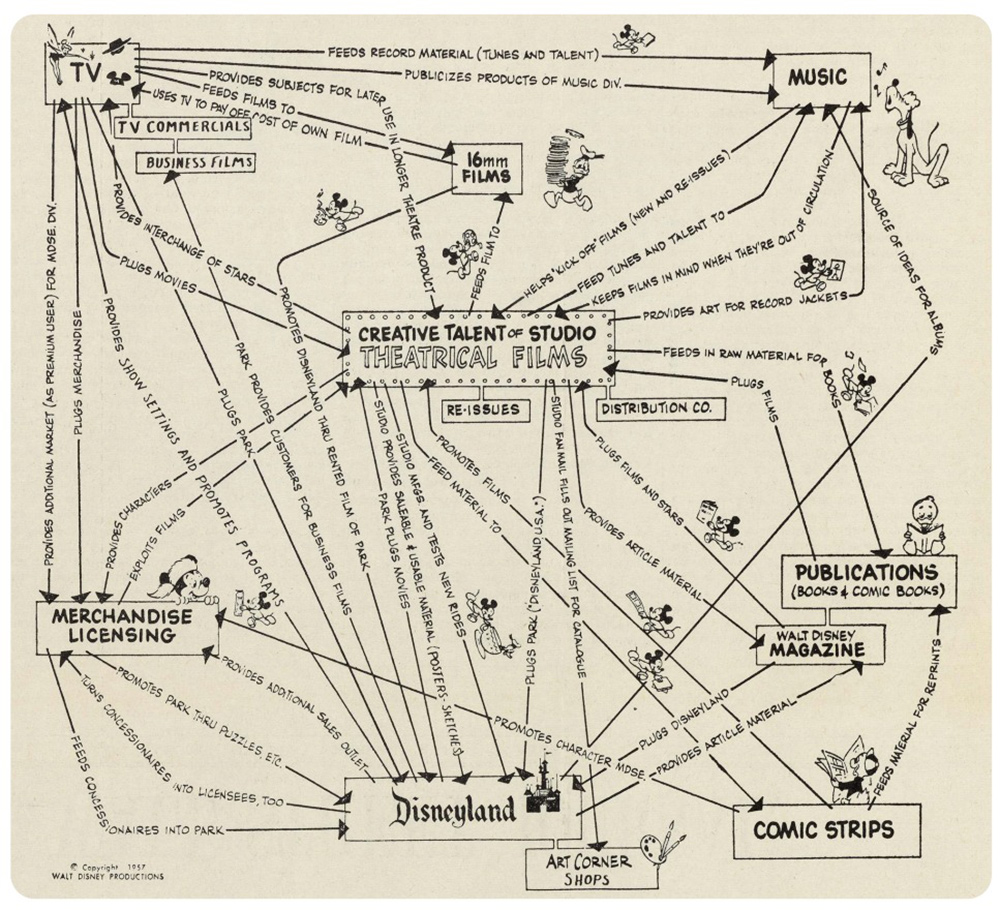 羅伯特·艾格(Bob Iger)重返迪士尼(Disney),再次擔(dān)任首席執(zhí)行官。圖片來源:ANGELA WEISS -AFP - GETTY IMAGES
羅伯特·艾格(Bob Iger)重返迪士尼(Disney),再次擔(dān)任首席執(zhí)行官。圖片來源:ANGELA WEISS -AFP - GETTY IMAGES本周,維權(quán)投資者尼爾森·佩爾茨(Nelson Peltz)與迪士尼董事會之間激烈的代理權(quán)之爭達(dá)到高潮,然而,人們很容易忘記,在扣人心弦的爭奪迪士尼控制權(quán)的戲劇性場面中,在雙方的人身攻擊中,代理權(quán)之爭只不過會導(dǎo)致首席執(zhí)行官羅伯特·艾格分心,而且相當(dāng)耗時耗力。在整個傳統(tǒng)媒體和娛樂行業(yè)受到來自科技巨頭及其顛覆性技術(shù)的前所未有的競爭威脅之際,羅伯特·艾格負(fù)責(zé)掌管迪士尼。
就其過去的表現(xiàn)而言,我們已經(jīng)證明佩爾茨和迪士尼首席執(zhí)行官羅伯特·艾格是截然不同的。佩爾茨是長期表現(xiàn)最差的維權(quán)投資者之一,長期以來一直在董事會中破壞價值,而艾格在兩度擔(dān)任首席執(zhí)行官期間,其股票表現(xiàn)遠(yuǎn)超媒體同行,為股東創(chuàng)造了超過1600億美元的價值,迪士尼是今年道瓊斯指數(shù)中表現(xiàn)最好的股票。
超越過去的業(yè)績,展望迪士尼的未來,艾格所做的不僅僅是維持迪斯尼的正常運(yùn)轉(zhuǎn):他寫就了媒體和娛樂業(yè)歷史上最令人矚目的扭虧為盈和轉(zhuǎn)型故事。仔細(xì)研究羅伯特·艾格為迪斯尼未來十年各業(yè)務(wù)線增長制定的戰(zhàn)略路線圖,就會發(fā)現(xiàn),如果說有哪家傳統(tǒng)媒體公司能在流媒體時代脫穎而出,獲得比傳統(tǒng)線性業(yè)務(wù)和有線電視業(yè)務(wù)更高的盈利能力,那非迪士尼莫屬。
流媒體:由于艾格的先見之明,迪士尼在傳統(tǒng)媒體同行中擁有先發(fā)優(yōu)勢
十多年前,羅伯特·艾格是最早預(yù)見到傳統(tǒng)“線性捆綁”即將衰落的媒體高管之一。不熟悉媒體業(yè)務(wù)的觀察人士可能無法理解,線性捆綁對傳統(tǒng)媒體公司來說是多么有利可圖,因?yàn)槠湓谙蛴芯€電視用戶提供內(nèi)容而獲得“傳輸費(fèi)”之外,還從廣告商那里獲得了意外的廣告收入。但隨著流媒體的普及以及掐線族的出現(xiàn),越來越多用戶取消了有線電視套餐,這使得許多媒體分析師認(rèn)為,線性捆綁的商業(yè)模式正走向長期衰落。
與一些被顛覆和失衡的媒體業(yè)同行不同,艾格力圖成為一個顛覆者,主動應(yīng)變,并為線性業(yè)務(wù)不再像過去那樣強(qiáng)勢的世界做好準(zhǔn)備,還在早期就投入到有線電視向流媒體的轉(zhuǎn)型中。盡管眾多批評者表示迪士尼不可能成功推出流媒體平臺,但當(dāng)艾格在2019年推出旗艦產(chǎn)品Disney+流媒體服務(wù)時,僅第一天就有1000萬訂戶,在艾格離任前的前15個月內(nèi)就有1億訂戶。
艾格多年來一直在為推出Disney+做準(zhǔn)備,他在2017年收購了流媒體技術(shù)公司BAMTech的股份。由于艾格的遠(yuǎn)見卓識和先見之明,迪士尼在實(shí)現(xiàn)從線性業(yè)務(wù)到流媒體的轉(zhuǎn)型方面遙遙領(lǐng)先于傳統(tǒng)媒體同行,其流媒體業(yè)務(wù)帶來的收入比傳統(tǒng)競爭對手多出數(shù)十億美元。此外,迪士尼流媒體平臺的總訂戶數(shù)超過了所有傳統(tǒng)媒體同行的總和,迪士尼流媒體平臺的全球訂戶數(shù)達(dá)到1.9億(相比之下,華納兄弟探索頻道(Warner Brothers Discovery)運(yùn)營的Max平臺的訂戶數(shù)不到1億;Paramount+的訂戶數(shù)約為6000萬,康卡斯特(Comcast)旗下NBC環(huán)球集團(tuán)(NBC Universal)運(yùn)營的Peacock的訂戶數(shù)約為3000萬;并讓大肆宣傳的Apple TV相形見絀,其訂戶數(shù)為2500萬)。

雖然網(wǎng)飛(Netflix)仍以約2.5億訂戶數(shù)保持領(lǐng)先地位,但迪士尼正在快速發(fā)展,就連網(wǎng)飛也承認(rèn)“我們兩家之間的決斗還將持續(xù)很長一段時間”。
盡管股市估值存在巨大差異,但迪斯尼擁有許多網(wǎng)飛所不具備的巨大優(yōu)勢,包括歷史悠久的資料庫和更多沒有時間限制的特許經(jīng)營項(xiàng)目、在消費(fèi)品、樂園和度假區(qū)之間產(chǎn)生的協(xié)同效應(yīng),以及真正的規(guī)模優(yōu)勢。
迪士尼去年的凈收入總額超過了網(wǎng)飛,而收入基數(shù)則是網(wǎng)飛的三倍。更不必提及迪士尼的創(chuàng)意引擎,當(dāng)它全速運(yùn)轉(zhuǎn)時,仍是無可比擬的:有些人可能會驚訝地發(fā)現(xiàn),在2023年,也就是艾格回歸的第一年,美國所有流媒體平臺上流量最大的10部電影中,有6部屬于迪士尼。
流媒體:未來收入仍有指數(shù)級增長潛力
盡管迪斯尼在訂戶增長方面取得了成功,但許多分析師擔(dān)心,流媒體時代帶來的貨幣化機(jī)會永遠(yuǎn)趕不上媒體和娛樂公司從傳統(tǒng)的線性/有線電視捆綁業(yè)務(wù)中獲得的暴利,而且在利潤空間不斷縮小的情況下,收入增長將難以為繼。但是,現(xiàn)在就敲響媒體和娛樂業(yè)盈利能力的喪鐘可能還為時過早。顯然,流媒體業(yè)務(wù)仍處于發(fā)展的初期階段。事實(shí)上,艾格是第一個承認(rèn)流媒體業(yè)務(wù)對迪士尼來說仍是一項(xiàng)“新興”業(yè)務(wù)的人,雖然迪士尼進(jìn)軍流媒體只有四年之久,但它仍在進(jìn)行實(shí)時學(xué)習(xí),并在軍備競賽中進(jìn)行相應(yīng)調(diào)整。
艾格已經(jīng)對迪士尼的流媒體業(yè)務(wù)進(jìn)行了重大改進(jìn),包括削減開支和適當(dāng)調(diào)整定價結(jié)構(gòu),以使流媒體平臺朝著長期增長和盈利的方向發(fā)展。因此,流媒體業(yè)務(wù)已經(jīng)從2019年開始時的每年虧損20億美元,轉(zhuǎn)變?yōu)榻衲甑娜嬗0駥?shí)現(xiàn)了流媒體平臺的增長,遠(yuǎn)遠(yuǎn)超過了線性業(yè)務(wù)的衰退速度,沒有像他的前任鮑勃·查佩克(Bob Chapek)那樣陷入自毀式的流媒體軍備競賽,沒有蠶食公司業(yè)務(wù),也沒有把控制權(quán)從創(chuàng)意官員轉(zhuǎn)移到欽點(diǎn)的副手卡里姆·丹尼爾(Kareem Daniel)手中,讓Disney+充斥太多無人問津的劣質(zhì)內(nèi)容。

迪斯尼仍有大量尚未開發(fā)的機(jī)會,不僅可以加速訂戶增長,還可以加快收入和利潤增長。在多次公開采訪中,艾格都表示流媒體廣告收入具有指數(shù)級增長潛力,尤其是更具個性化、更有針對性的數(shù)字廣告,這對廣告商來說比傳統(tǒng)的線性電視廣告模式更有價值。就像幾乎所有競爭對手所做的那樣,如果迪斯尼繼續(xù)拉大無廣告和有廣告支持的流媒體訂閱套餐之間的定價差距,那么流媒體廣告收入的增長速度就會進(jìn)一步加快。令人驚訝的是,迪斯尼仍然擁有競爭對手中最便宜的免廣告套餐月費(fèi):Disney+的免廣告套餐月費(fèi)13.99美元,比網(wǎng)飛15.49美元的免廣告套餐月費(fèi)便宜,也比Max的15.99美元的免廣告套餐月費(fèi)便宜。同樣令人吃驚的是,迪斯尼沒有高級版套餐,而競爭對手如網(wǎng)飛和Max,則分別從22.99美元的高級版套餐和19.99美元高級版套餐中賺取利潤。至少從紙面上看,迪斯尼有相當(dāng)大的空間提高無廣告訂閱套餐的價格。提高價格并不一定會影響可及性和可負(fù)擔(dān)性:Disney+ 7.99美元的廣告支持訂閱層級對消費(fèi)者來說仍然非常實(shí)惠,對迪斯尼的廣告收入也能起到極大的促進(jìn)作用。
此外,迪士尼還計(jì)劃在今年晚些時候完成從康卡斯特手中收購Hulu全部股權(quán)的協(xié)議,將Hulu與迪士尼全資擁有的流媒體平臺Disney+和ESPN+全面整合,這也將為迪斯尼帶來尚未開發(fā)的商機(jī)。
迪士尼甚至一開始就擁有Hulu的股份,這證明了艾格的先見之明。如果艾格沒有在2018年從魯伯特·默多克(Rupert Murdoch)手中收購21世紀(jì)福克斯,康卡斯特就會收購21世紀(jì)福克斯(Hulu是21世紀(jì)福克斯的一部分),那么康卡斯特很可能會在今天的流媒體領(lǐng)域領(lǐng)先迪士尼,而不是遠(yuǎn)遠(yuǎn)落后,畢竟Peacock只有3000萬訂戶,不到迪士尼訂戶數(shù)的六分之一。對于艾格收購福克斯的交易,最令人信服的批評是,也許他應(yīng)該從時代華納(Time Warner)的傳奇首席執(zhí)行官杰夫·比克斯(Jeff Bewkes)手中收購時代華納,而不是21世紀(jì)福克斯,因?yàn)闀r代華納的資產(chǎn),包括HBO和華納兄弟(Warner Bros)的內(nèi)容庫,可能與迪士尼的品牌家族更適配。
另一個被低估的機(jī)會來自于新興流媒體行業(yè)的逐漸成熟。2022年,傳統(tǒng)媒體公司的流媒體損失總額將超過100億美元,流媒體軍備競賽的時代很可能在更節(jié)制的內(nèi)容創(chuàng)作和支出中終結(jié)。雖然大型科技公司繼續(xù)大舉進(jìn)軍媒體和娛樂業(yè)務(wù),但眾多流媒體平臺卻因缺乏獲取內(nèi)容的渠道而難以起步。由于不利的反壟斷監(jiān)管環(huán)境,它們很難通過無機(jī)并購購買到迫切需要的內(nèi)容庫,這為擁有領(lǐng)先流媒體平臺的迪士尼和網(wǎng)飛提供了巨大的競爭優(yōu)勢。
線性:彌合轉(zhuǎn)型差距,削減成本,同時巧妙避免低價銷售
艾格成功駕馭了流媒體革命,真正實(shí)現(xiàn)了從線性業(yè)務(wù)的轉(zhuǎn)型,并讓線性業(yè)務(wù)繼續(xù)蓬勃發(fā)展,從而開拓了兩全其美的局面。
盡管線性商業(yè)模式面臨嚴(yán)重壓力,但迪士尼旗下的美國廣播公司(ABC)和美國廣播公司旗下的電視臺仍能帶來健康收入和利潤。如果線性廣告市場恢復(fù)到更正常的水平,尤其是在今年秋天總統(tǒng)大選(以及相關(guān)的廣告支出)日益臨近的情況下,那么就像許多人預(yù)期的那樣,收入還有一定的增長潛力。
盡管有大量潛在買家出價,艾格還是巧妙地拒絕以低價出售,同時專注于降低成本,迪士尼節(jié)省的75億美元成本中有很大一部分來自線性成本。艾格還精簡了線性業(yè)務(wù),將重點(diǎn)放在核心頻道上,并削減了經(jīng)濟(jì)效益和可行性較差的第三頻道。
迪斯尼最近與Charter的談判為迪斯尼如何繼續(xù)支持傳統(tǒng)的線性商業(yè)模式提供了實(shí)現(xiàn)雙贏的藍(lán)圖,同時也能助力其順利彌合與流媒體業(yè)務(wù)之間的差距,而迪斯尼則以批發(fā)價向Charter客戶提供廣告支持的Disney+流媒體訂閱服務(wù)(折扣版),為有線電視客戶提供了簡單實(shí)惠的流媒體選擇,以補(bǔ)充其現(xiàn)有的有線電視訂閱服務(wù)。
制片廠:注重質(zhì)量,而非數(shù)量
在羅伯特·艾格擔(dān)任首席執(zhí)行官的第一個任期內(nèi),迪士尼制作了有史以來票房最高的前10部電影中的8部,以及前20部電影中的13部,票房收入都超過了10億美元。相比之下,鮑勃·查佩克制作的電影沒有一部票房收入超過10億美元。
查佩克注重權(quán)力集中,用備受矚目的口水仗疏離創(chuàng)意人才,而艾格與他不同,他明白迪士尼的核心是一家講故事的公司,而且知道如何拍出好電影。
為此,艾格將質(zhì)量放在首位,而非數(shù)量。他坦率地表示:“數(shù)量有時會影響質(zhì)量。在我們熱衷于大幅提高數(shù)量的過程中,部分制片廠失去了重點(diǎn)。因此,我們首先采取的措施就是減少數(shù)量,尤其是在漫威(Marvel)電影領(lǐng)域。”
迪士尼體驗(yàn)項(xiàng)目(樂園與度假區(qū)):全面刷新紀(jì)錄
迪士尼體驗(yàn)項(xiàng)目(包括其重要樂園和度假區(qū))的營收數(shù)字不言而喻:不僅游客人數(shù)不斷刷新紀(jì)錄,國內(nèi)游客人數(shù)更是疫情爆發(fā)前的兩倍,而且2023年的收入、營業(yè)收入和營業(yè)利潤率也創(chuàng)下了歷史新高。
更重要的是,艾格認(rèn)識到樂園和度假區(qū)對迪士尼品牌和全球家庭的重要意義,緩和了前任查佩克帶來的苛刻而不受歡迎的消費(fèi)價格上漲。查佩克曾將樂園價格上漲作為彌補(bǔ)流媒體損失的“餅干罐”。
艾格并沒有為了資助自己青睞的項(xiàng)目而蠶食迪士尼樂園和度假區(qū)的利益,而是投資于增長和可負(fù)擔(dān)性。他計(jì)劃在未來十年投資600億美元,以實(shí)現(xiàn)持續(xù)增長,這反映出在過去十年中,樂園和度假區(qū)的投資資本回報(bào)率是所有業(yè)務(wù)線中最高的,也是少數(shù)幾個不受大型科技公司競爭影響的業(yè)務(wù)線之一。
體育:在眾多選擇中屹立不倒
正如艾格喜歡調(diào)侃的那樣,“體育將繼續(xù)在娛樂業(yè)的眾多選擇中屹立不倒”,艾格致力于將ESPN打造成唯一領(lǐng)先的數(shù)字體育平臺,從而實(shí)現(xiàn)迪士尼在體育領(lǐng)域的發(fā)展。
ESPN Bets等新插件反映了這一愿景,但這只是冰山一角:預(yù)計(jì)明年推出的沉浸式旗艦產(chǎn)品直接面向消費(fèi)者的ESPN將包括綜合投注、虛擬比賽、購物、統(tǒng)計(jì)、定制和個性化等功能,旨在吸引從普通粉絲到鐵桿粉絲的所有體育迷。艾格巧妙地拒絕引入增值能力有待商榷的戰(zhàn)略合作伙伴,也拒絕廉價出售ESPN。
此外,迪斯尼與福克斯公司和華納兄弟探索頻道新成立的體育合資公司,在任命蘋果公司(Apple)資深高管皮特·迪斯塔德(Pete Distad)擔(dān)任負(fù)責(zé)人后,開局良好。實(shí)現(xiàn)體育內(nèi)容捆綁不僅能緩解現(xiàn)有用戶的不滿情緒,還能進(jìn)軍能夠?qū)崿F(xiàn)巨大增長的市場。畢竟,在美國1.25億戶家庭中,超過6000萬戶家庭不在傳統(tǒng)的有線電視捆綁生態(tài)系統(tǒng)中,他們迫切希望能在一個平臺上觀看更多自己喜歡的體育節(jié)目。
迪士尼已經(jīng)發(fā)現(xiàn),只要提供“捆綁”套餐,客戶流失率就會大幅下降,因此有理由認(rèn)為,流媒體服務(wù)和有線電視客戶將實(shí)現(xiàn)深度捆綁,以確保全面減少雜亂無章的客戶體驗(yàn)。
游戲等新業(yè)務(wù)線
華特·迪士尼 (Walt Disney) 親自繪制的傳奇迪斯尼飛輪正在不斷擴(kuò)張,每一條新業(yè)務(wù)線都會依托并促進(jìn)相鄰業(yè)務(wù)線的發(fā)展勢頭。艾格從不懼怕為擴(kuò)大飛輪而進(jìn)行大膽飛躍,比如迪斯尼新近斥資15億美元收購電子游戲制造商Epic Games。千禧一代花在游戲上的時間和看電視或電影的時間一樣多,電子游戲?qū)Φ纤鼓醽碚f不僅是一項(xiàng)高利潤的附加業(yè)務(wù),而且是提升迪斯尼現(xiàn)有品牌特許經(jīng)營權(quán)(尤其是漫威和星球大戰(zhàn))價值和深度的天然附加產(chǎn)品。

艾格對未來的愿景令人信服,這也是為什么即使是其他維權(quán)投資者——比如ValueAct公司精明而富有建設(shè)性的梅森·莫菲特(Mason Morfit),他的身價去年增加了46%——也大力支持這位迪士尼首席執(zhí)行官。
艾格在迪斯尼的業(yè)績不容忽視,但他并沒有沉溺于過去。相反,當(dāng)媒體分析師們在一旁束手無策,抱怨媒體和娛樂公司的黃金時代已經(jīng)終結(jié),收入增長將一去不復(fù)返,或是流媒體永遠(yuǎn)不會像線性捆綁那樣帶來利潤時,艾格已經(jīng)為現(xiàn)代娛樂公司構(gòu)建了全新的愿景和實(shí)現(xiàn)創(chuàng)新的藍(lán)圖。
影評人羅杰·埃伯特(Roger Ebert)曾經(jīng)打趣說:“好電影都不會太長,而糟糕電影都不會太短!”羅伯特·艾格精心制定的跨業(yè)務(wù)線增長計(jì)劃,將確保神奇王國繼續(xù)沿著魔毯之路前進(jìn),這也是他在未來多年擔(dān)任迪士尼首席執(zhí)行官期間重點(diǎn)關(guān)注的事項(xiàng)。(財(cái)富中文網(wǎng))
杰弗里·索南費(fèi)爾德(Jeffrey Sonnenfeld)是萊斯特·克朗管理實(shí)踐教授、耶魯大學(xué)首席執(zhí)行官領(lǐng)導(dǎo)力研究所的創(chuàng)始人和總裁。2023年,他被《詩人與量化》雜志(Poets & Quants)評為“年度管理學(xué)教授”。
史蒂文·田(Steven Tian)是耶魯大學(xué)首席執(zhí)行官領(lǐng)導(dǎo)力研究所研究部主任,曾任洛克菲勒家族辦公室的量化投資分析師。
譯者:中慧言-王芳
本周,維權(quán)投資者尼爾森·佩爾茨(Nelson Peltz)與迪士尼董事會之間激烈的代理權(quán)之爭達(dá)到高潮,然而,人們很容易忘記,在扣人心弦的爭奪迪士尼控制權(quán)的戲劇性場面中,在雙方的人身攻擊中,代理權(quán)之爭只不過會導(dǎo)致首席執(zhí)行官羅伯特·艾格分心,而且相當(dāng)耗時耗力。在整個傳統(tǒng)媒體和娛樂行業(yè)受到來自科技巨頭及其顛覆性技術(shù)的前所未有的競爭威脅之際,羅伯特·艾格負(fù)責(zé)掌管迪士尼。
就其過去的表現(xiàn)而言,我們已經(jīng)證明佩爾茨和迪士尼首席執(zhí)行官羅伯特·艾格是截然不同的。佩爾茨是長期表現(xiàn)最差的維權(quán)投資者之一,長期以來一直在董事會中破壞價值,而艾格在兩度擔(dān)任首席執(zhí)行官期間,其股票表現(xiàn)遠(yuǎn)超媒體同行,為股東創(chuàng)造了超過1600億美元的價值,迪士尼是今年道瓊斯指數(shù)中表現(xiàn)最好的股票。
超越過去的業(yè)績,展望迪士尼的未來,艾格所做的不僅僅是維持迪斯尼的正常運(yùn)轉(zhuǎn):他寫就了媒體和娛樂業(yè)歷史上最令人矚目的扭虧為盈和轉(zhuǎn)型故事。仔細(xì)研究羅伯特·艾格為迪斯尼未來十年各業(yè)務(wù)線增長制定的戰(zhàn)略路線圖,就會發(fā)現(xiàn),如果說有哪家傳統(tǒng)媒體公司能在流媒體時代脫穎而出,獲得比傳統(tǒng)線性業(yè)務(wù)和有線電視業(yè)務(wù)更高的盈利能力,那非迪士尼莫屬。
流媒體:由于艾格的先見之明,迪士尼在傳統(tǒng)媒體同行中擁有先發(fā)優(yōu)勢
十多年前,羅伯特·艾格是最早預(yù)見到傳統(tǒng)“線性捆綁”即將衰落的媒體高管之一。不熟悉媒體業(yè)務(wù)的觀察人士可能無法理解,線性捆綁對傳統(tǒng)媒體公司來說是多么有利可圖,因?yàn)槠湓谙蛴芯€電視用戶提供內(nèi)容而獲得“傳輸費(fèi)”之外,還從廣告商那里獲得了意外的廣告收入。但隨著流媒體的普及以及掐線族的出現(xiàn),越來越多用戶取消了有線電視套餐,這使得許多媒體分析師認(rèn)為,線性捆綁的商業(yè)模式正走向長期衰落。
與一些被顛覆和失衡的媒體業(yè)同行不同,艾格力圖成為一個顛覆者,主動應(yīng)變,并為線性業(yè)務(wù)不再像過去那樣強(qiáng)勢的世界做好準(zhǔn)備,還在早期就投入到有線電視向流媒體的轉(zhuǎn)型中。盡管眾多批評者表示迪士尼不可能成功推出流媒體平臺,但當(dāng)艾格在2019年推出旗艦產(chǎn)品Disney+流媒體服務(wù)時,僅第一天就有1000萬訂戶,在艾格離任前的前15個月內(nèi)就有1億訂戶。
艾格多年來一直在為推出Disney+做準(zhǔn)備,他在2017年收購了流媒體技術(shù)公司BAMTech的股份。由于艾格的遠(yuǎn)見卓識和先見之明,迪士尼在實(shí)現(xiàn)從線性業(yè)務(wù)到流媒體的轉(zhuǎn)型方面遙遙領(lǐng)先于傳統(tǒng)媒體同行,其流媒體業(yè)務(wù)帶來的收入比傳統(tǒng)競爭對手多出數(shù)十億美元。此外,迪士尼流媒體平臺的總訂戶數(shù)超過了所有傳統(tǒng)媒體同行的總和,迪士尼流媒體平臺的全球訂戶數(shù)達(dá)到1.9億(相比之下,華納兄弟探索頻道(Warner Brothers Discovery)運(yùn)營的Max平臺的訂戶數(shù)不到1億;Paramount+的訂戶數(shù)約為6000萬,康卡斯特(Comcast)旗下NBC環(huán)球集團(tuán)(NBC Universal)運(yùn)營的Peacock的訂戶數(shù)約為3000萬;并讓大肆宣傳的Apple TV相形見絀,其訂戶數(shù)為2500萬)。
雖然網(wǎng)飛(Netflix)仍以約2.5億訂戶數(shù)保持領(lǐng)先地位,但迪士尼正在快速發(fā)展,就連網(wǎng)飛也承認(rèn)“我們兩家之間的決斗還將持續(xù)很長一段時間”。
盡管股市估值存在巨大差異,但迪斯尼擁有許多網(wǎng)飛所不具備的巨大優(yōu)勢,包括歷史悠久的資料庫和更多沒有時間限制的特許經(jīng)營項(xiàng)目、在消費(fèi)品、樂園和度假區(qū)之間產(chǎn)生的協(xié)同效應(yīng),以及真正的規(guī)模優(yōu)勢。
迪士尼去年的凈收入總額超過了網(wǎng)飛,而收入基數(shù)則是網(wǎng)飛的三倍。更不必提及迪士尼的創(chuàng)意引擎,當(dāng)它全速運(yùn)轉(zhuǎn)時,仍是無可比擬的:有些人可能會驚訝地發(fā)現(xiàn),在2023年,也就是艾格回歸的第一年,美國所有流媒體平臺上流量最大的10部電影中,有6部屬于迪士尼。
流媒體:未來收入仍有指數(shù)級增長潛力
盡管迪斯尼在訂戶增長方面取得了成功,但許多分析師擔(dān)心,流媒體時代帶來的貨幣化機(jī)會永遠(yuǎn)趕不上媒體和娛樂公司從傳統(tǒng)的線性/有線電視捆綁業(yè)務(wù)中獲得的暴利,而且在利潤空間不斷縮小的情況下,收入增長將難以為繼。但是,現(xiàn)在就敲響媒體和娛樂業(yè)盈利能力的喪鐘可能還為時過早。顯然,流媒體業(yè)務(wù)仍處于發(fā)展的初期階段。事實(shí)上,艾格是第一個承認(rèn)流媒體業(yè)務(wù)對迪士尼來說仍是一項(xiàng)“新興”業(yè)務(wù)的人,雖然迪士尼進(jìn)軍流媒體只有四年之久,但它仍在進(jìn)行實(shí)時學(xué)習(xí),并在軍備競賽中進(jìn)行相應(yīng)調(diào)整。
艾格已經(jīng)對迪士尼的流媒體業(yè)務(wù)進(jìn)行了重大改進(jìn),包括削減開支和適當(dāng)調(diào)整定價結(jié)構(gòu),以使流媒體平臺朝著長期增長和盈利的方向發(fā)展。因此,流媒體業(yè)務(wù)已經(jīng)從2019年開始時的每年虧損20億美元,轉(zhuǎn)變?yōu)榻衲甑娜嬗0駥?shí)現(xiàn)了流媒體平臺的增長,遠(yuǎn)遠(yuǎn)超過了線性業(yè)務(wù)的衰退速度,沒有像他的前任鮑勃·查佩克(Bob Chapek)那樣陷入自毀式的流媒體軍備競賽,沒有蠶食公司業(yè)務(wù),也沒有把控制權(quán)從創(chuàng)意官員轉(zhuǎn)移到欽點(diǎn)的副手卡里姆·丹尼爾(Kareem Daniel)手中,讓Disney+充斥太多無人問津的劣質(zhì)內(nèi)容。
迪斯尼仍有大量尚未開發(fā)的機(jī)會,不僅可以加速訂戶增長,還可以加快收入和利潤增長。在多次公開采訪中,艾格都表示流媒體廣告收入具有指數(shù)級增長潛力,尤其是更具個性化、更有針對性的數(shù)字廣告,這對廣告商來說比傳統(tǒng)的線性電視廣告模式更有價值。就像幾乎所有競爭對手所做的那樣,如果迪斯尼繼續(xù)拉大無廣告和有廣告支持的流媒體訂閱套餐之間的定價差距,那么流媒體廣告收入的增長速度就會進(jìn)一步加快。令人驚訝的是,迪斯尼仍然擁有競爭對手中最便宜的免廣告套餐月費(fèi):Disney+的免廣告套餐月費(fèi)13.99美元,比網(wǎng)飛15.49美元的免廣告套餐月費(fèi)便宜,也比Max的15.99美元的免廣告套餐月費(fèi)便宜。同樣令人吃驚的是,迪斯尼沒有高級版套餐,而競爭對手如網(wǎng)飛和Max,則分別從22.99美元的高級版套餐和19.99美元高級版套餐中賺取利潤。至少從紙面上看,迪斯尼有相當(dāng)大的空間提高無廣告訂閱套餐的價格。提高價格并不一定會影響可及性和可負(fù)擔(dān)性:Disney+ 7.99美元的廣告支持訂閱層級對消費(fèi)者來說仍然非常實(shí)惠,對迪斯尼的廣告收入也能起到極大的促進(jìn)作用。
此外,迪士尼還計(jì)劃在今年晚些時候完成從康卡斯特手中收購Hulu全部股權(quán)的協(xié)議,將Hulu與迪士尼全資擁有的流媒體平臺Disney+和ESPN+全面整合,這也將為迪斯尼帶來尚未開發(fā)的商機(jī)。
迪士尼甚至一開始就擁有Hulu的股份,這證明了艾格的先見之明。如果艾格沒有在2018年從魯伯特·默多克(Rupert Murdoch)手中收購21世紀(jì)福克斯,康卡斯特就會收購21世紀(jì)福克斯(Hulu是21世紀(jì)福克斯的一部分),那么康卡斯特很可能會在今天的流媒體領(lǐng)域領(lǐng)先迪士尼,而不是遠(yuǎn)遠(yuǎn)落后,畢竟Peacock只有3000萬訂戶,不到迪士尼訂戶數(shù)的六分之一。對于艾格收購福克斯的交易,最令人信服的批評是,也許他應(yīng)該從時代華納(Time Warner)的傳奇首席執(zhí)行官杰夫·比克斯(Jeff Bewkes)手中收購時代華納,而不是21世紀(jì)福克斯,因?yàn)闀r代華納的資產(chǎn),包括HBO和華納兄弟(Warner Bros)的內(nèi)容庫,可能與迪士尼的品牌家族更適配。
另一個被低估的機(jī)會來自于新興流媒體行業(yè)的逐漸成熟。2022年,傳統(tǒng)媒體公司的流媒體損失總額將超過100億美元,流媒體軍備競賽的時代很可能在更節(jié)制的內(nèi)容創(chuàng)作和支出中終結(jié)。雖然大型科技公司繼續(xù)大舉進(jìn)軍媒體和娛樂業(yè)務(wù),但眾多流媒體平臺卻因缺乏獲取內(nèi)容的渠道而難以起步。由于不利的反壟斷監(jiān)管環(huán)境,它們很難通過無機(jī)并購購買到迫切需要的內(nèi)容庫,這為擁有領(lǐng)先流媒體平臺的迪士尼和網(wǎng)飛提供了巨大的競爭優(yōu)勢。
線性:彌合轉(zhuǎn)型差距,削減成本,同時巧妙避免低價銷售
艾格成功駕馭了流媒體革命,真正實(shí)現(xiàn)了從線性業(yè)務(wù)的轉(zhuǎn)型,并讓線性業(yè)務(wù)繼續(xù)蓬勃發(fā)展,從而開拓了兩全其美的局面。
盡管線性商業(yè)模式面臨嚴(yán)重壓力,但迪士尼旗下的美國廣播公司(ABC)和美國廣播公司旗下的電視臺仍能帶來健康收入和利潤。如果線性廣告市場恢復(fù)到更正常的水平,尤其是在今年秋天總統(tǒng)大選(以及相關(guān)的廣告支出)日益臨近的情況下,那么就像許多人預(yù)期的那樣,收入還有一定的增長潛力。
盡管有大量潛在買家出價,艾格還是巧妙地拒絕以低價出售,同時專注于降低成本,迪士尼節(jié)省的75億美元成本中有很大一部分來自線性成本。艾格還精簡了線性業(yè)務(wù),將重點(diǎn)放在核心頻道上,并削減了經(jīng)濟(jì)效益和可行性較差的第三頻道。
迪斯尼最近與Charter的談判為迪斯尼如何繼續(xù)支持傳統(tǒng)的線性商業(yè)模式提供了實(shí)現(xiàn)雙贏的藍(lán)圖,同時也能助力其順利彌合與流媒體業(yè)務(wù)之間的差距,而迪斯尼則以批發(fā)價向Charter客戶提供廣告支持的Disney+流媒體訂閱服務(wù)(折扣版),為有線電視客戶提供了簡單實(shí)惠的流媒體選擇,以補(bǔ)充其現(xiàn)有的有線電視訂閱服務(wù)。
制片廠:注重質(zhì)量,而非數(shù)量
在羅伯特·艾格擔(dān)任首席執(zhí)行官的第一個任期內(nèi),迪士尼制作了有史以來票房最高的前10部電影中的8部,以及前20部電影中的13部,票房收入都超過了10億美元。相比之下,鮑勃·查佩克制作的電影沒有一部票房收入超過10億美元。
查佩克注重權(quán)力集中,用備受矚目的口水仗疏離創(chuàng)意人才,而艾格與他不同,他明白迪士尼的核心是一家講故事的公司,而且知道如何拍出好電影。
為此,艾格將質(zhì)量放在首位,而非數(shù)量。他坦率地表示:“數(shù)量有時會影響質(zhì)量。在我們熱衷于大幅提高數(shù)量的過程中,部分制片廠失去了重點(diǎn)。因此,我們首先采取的措施就是減少數(shù)量,尤其是在漫威(Marvel)電影領(lǐng)域。”
迪士尼體驗(yàn)項(xiàng)目(樂園與度假區(qū)):全面刷新紀(jì)錄
迪士尼體驗(yàn)項(xiàng)目(包括其重要樂園和度假區(qū))的營收數(shù)字不言而喻:不僅游客人數(shù)不斷刷新紀(jì)錄,國內(nèi)游客人數(shù)更是疫情爆發(fā)前的兩倍,而且2023年的收入、營業(yè)收入和營業(yè)利潤率也創(chuàng)下了歷史新高。
更重要的是,艾格認(rèn)識到樂園和度假區(qū)對迪士尼品牌和全球家庭的重要意義,緩和了前任查佩克帶來的苛刻而不受歡迎的消費(fèi)價格上漲。查佩克曾將樂園價格上漲作為彌補(bǔ)流媒體損失的“餅干罐”。
艾格并沒有為了資助自己青睞的項(xiàng)目而蠶食迪士尼樂園和度假區(qū)的利益,而是投資于增長和可負(fù)擔(dān)性。他計(jì)劃在未來十年投資600億美元,以實(shí)現(xiàn)持續(xù)增長,這反映出在過去十年中,樂園和度假區(qū)的投資資本回報(bào)率是所有業(yè)務(wù)線中最高的,也是少數(shù)幾個不受大型科技公司競爭影響的業(yè)務(wù)線之一。
體育:在眾多選擇中屹立不倒
正如艾格喜歡調(diào)侃的那樣,“體育將繼續(xù)在娛樂業(yè)的眾多選擇中屹立不倒”,艾格致力于將ESPN打造成唯一領(lǐng)先的數(shù)字體育平臺,從而實(shí)現(xiàn)迪士尼在體育領(lǐng)域的發(fā)展。
ESPN Bets等新插件反映了這一愿景,但這只是冰山一角:預(yù)計(jì)明年推出的沉浸式旗艦產(chǎn)品直接面向消費(fèi)者的ESPN將包括綜合投注、虛擬比賽、購物、統(tǒng)計(jì)、定制和個性化等功能,旨在吸引從普通粉絲到鐵桿粉絲的所有體育迷。艾格巧妙地拒絕引入增值能力有待商榷的戰(zhàn)略合作伙伴,也拒絕廉價出售ESPN。
此外,迪斯尼與福克斯公司和華納兄弟探索頻道新成立的體育合資公司,在任命蘋果公司(Apple)資深高管皮特·迪斯塔德(Pete Distad)擔(dān)任負(fù)責(zé)人后,開局良好。實(shí)現(xiàn)體育內(nèi)容捆綁不僅能緩解現(xiàn)有用戶的不滿情緒,還能進(jìn)軍能夠?qū)崿F(xiàn)巨大增長的市場。畢竟,在美國1.25億戶家庭中,超過6000萬戶家庭不在傳統(tǒng)的有線電視捆綁生態(tài)系統(tǒng)中,他們迫切希望能在一個平臺上觀看更多自己喜歡的體育節(jié)目。
迪士尼已經(jīng)發(fā)現(xiàn),只要提供“捆綁”套餐,客戶流失率就會大幅下降,因此有理由認(rèn)為,流媒體服務(wù)和有線電視客戶將實(shí)現(xiàn)深度捆綁,以確保全面減少雜亂無章的客戶體驗(yàn)。
游戲等新業(yè)務(wù)線
華特·迪士尼 (Walt Disney) 親自繪制的傳奇迪斯尼飛輪正在不斷擴(kuò)張,每一條新業(yè)務(wù)線都會依托并促進(jìn)相鄰業(yè)務(wù)線的發(fā)展勢頭。艾格從不懼怕為擴(kuò)大飛輪而進(jìn)行大膽飛躍,比如迪斯尼新近斥資15億美元收購電子游戲制造商Epic Games。千禧一代花在游戲上的時間和看電視或電影的時間一樣多,電子游戲?qū)Φ纤鼓醽碚f不僅是一項(xiàng)高利潤的附加業(yè)務(wù),而且是提升迪斯尼現(xiàn)有品牌特許經(jīng)營權(quán)(尤其是漫威和星球大戰(zhàn))價值和深度的天然附加產(chǎn)品。
艾格對未來的愿景令人信服,這也是為什么即使是其他維權(quán)投資者——比如ValueAct公司精明而富有建設(shè)性的梅森·莫菲特(Mason Morfit),他的身價去年增加了46%——也大力支持這位迪士尼首席執(zhí)行官。
艾格在迪斯尼的業(yè)績不容忽視,但他并沒有沉溺于過去。相反,當(dāng)媒體分析師們在一旁束手無策,抱怨媒體和娛樂公司的黃金時代已經(jīng)終結(jié),收入增長將一去不復(fù)返,或是流媒體永遠(yuǎn)不會像線性捆綁那樣帶來利潤時,艾格已經(jīng)為現(xiàn)代娛樂公司構(gòu)建了全新的愿景和實(shí)現(xiàn)創(chuàng)新的藍(lán)圖。
影評人羅杰·埃伯特(Roger Ebert)曾經(jīng)打趣說:“好電影都不會太長,而糟糕電影都不會太短!”羅伯特·艾格精心制定的跨業(yè)務(wù)線增長計(jì)劃,將確保神奇王國繼續(xù)沿著魔毯之路前進(jìn),這也是他在未來多年擔(dān)任迪士尼首席執(zhí)行官期間重點(diǎn)關(guān)注的事項(xiàng)。(財(cái)富中文網(wǎng))
杰弗里·索南費(fèi)爾德(Jeffrey Sonnenfeld)是萊斯特·克朗管理實(shí)踐教授、耶魯大學(xué)首席執(zhí)行官領(lǐng)導(dǎo)力研究所的創(chuàng)始人和總裁。2023年,他被《詩人與量化》雜志(Poets & Quants)評為“年度管理學(xué)教授”。
史蒂文·田(Steven Tian)是耶魯大學(xué)首席執(zhí)行官領(lǐng)導(dǎo)力研究所研究部主任,曾任洛克菲勒家族辦公室的量化投資分析師。
譯者:中慧言-王芳
As the heated proxy fight between activist investor Nelson Peltz and Disney’s board reaches its grand finale this week, it’s easy to forget that amidst the gripping drama of the fight for control of Disney, and a fusillade of personal barbs from both sides, the proxy fight is nothing more than a time-consuming distraction for CEO Bob Iger, who is running Disney at a time when the entire traditional media and entertainment industry is under siege with an unprecedented array of competitive threats from Big Tech and its disruption.
Already, we have shown how, in terms of their past performance, Peltz and Disney CEO Bob Iger could not be more different. While Peltz is one of the chronically poorest-performing activist investors, with a long history of destroying value when he sits on boards, Iger has towered over media peers in stock performance across his two stints as CEO, generating over $160 billion in shareholder value, with Disney being the top-performing stock on the Dow this year.
Looking beyond past performance, and towards the future of Disney, Iger is doing more than keeping the lights on: he is pulling off one of the most remarkable turnaround and transformation stories in media and entertainment history. A close look at Bob Iger’s strategic roadmap for the next decade of growth across business lines at Disney clearly shows that if there is any traditional media company that will emerge from the streaming era with even greater profitability than its traditional linear and cable businesses ever achieved, it will be Disney.
Streaming: Disney was first mover among traditional media peers thanks to Iger’s prescience
Over a decade ago, Bob Iger was one of the first media executives to see the decline of the traditional “l(fā)inear bundle” coming. Observers not steeped in the media business may not understand just how lucrative the linear bundle was for traditional media companies, as they raked in windfall advertising revenue from advertisers on top of “carriage fees” for providing content to cable customers. But with the popularization of streaming and subsequent cord-cutting, more customers are canceling their cable TV packages, which leads many media analysts to believe that the linear bundle business model is now in secular decline.
Unlike some of his media industry peers who were disrupted and caught off balance, Iger sought to be a disruptor, proactively preparing for a world where the linear business is not as strong as it used to be, and leaning into the cable-to-streaming migration early on. When Iger launched the flagship Disney+ streaming service in 2019, although a chorus of critics said at the time that Disney could never successfully launch a streaming platform, 10 million subscribers signed up on the first day alone, and 100 million within the first 15 months before Iger left office.
Iger had already been preparing for its launch for years, buying a stake in streaming tech company BAMTech in 2017. As a result of Iger’s vision and prescience, Disney is way ahead of traditional media peers in bridging the linear-to-streaming transition, with its streaming business driving billions more in revenue than any of its legacy competitors. Furthermore, Disney’s streaming platforms boast a total subscriber count greater than all its traditional media peers combined, with 190 million global subscribers across the Disney streaming platforms (compared to less than 100 million for Max run by Warner Brothers Discovery; ~60 million on Paramount+, and ~30 million on Peacock, run by Comcast’s NBC Universal; and dwarfing the 25 million subscribers of the much-ballyhooed Apple TV).
While Netflix remains in the lead with ~250 million subscribers, Disney is making fast progress, with even Netflix acknowledging that “it will be….the two of us duking it out for a long time.”
Disney possesses many significant advantages that Netflix does not have, including a deeper historical library and more timeless franchises with synergies across consumer products and parks and resorts, as well as pure scale–despite vastly divergent stock market valuations.
Disney’s total net income surpassed that of Netflix’s last year, with a revenue base three times larger. Not to mention Disney’s creative engine, when working at full force, remains unparalleled: Some may be surprised to know that in 2023, the first full year of Iger’s return, six of the top 10 most streamed movies across all streaming platforms in the U.S. belonged to Disney.
Streaming: Still potential for exponential future revenue growth ahead
Despite Disney’s success in signing up subscribers, many analysts fear that the monetization opportunities from the streaming era will never catch up to the windfall profits historically reaped by media and entertainment companies from the traditional linear/cable bundle–and that revenue growth will be hard to drive moving forward amidst shrinking profit margins. But it may be too early to ring the death knell of media and entertainment profitability. It’s clear that the streaming business is still in its earliest innings of development. Indeed, Iger is the first to acknowledge that streaming is still a “nascent” business for Disney, merely four years old, and that Disney is still learning in real time and making in-game adjustments.
Already, Iger has overseen dramatic improvements in Disney’s streaming business–including reducing expenses and scaling the pricing structure appropriately–to build the streaming platforms toward long-term growth and profitability. As a result, the streaming business has inflected from generating $2 billion a year in losses when it started in 2019 to full profitability this year. Iger has managed the growth of the streaming platforms responsibly, far outpacing the decline of the linear business, without falling into the self-destructive streaming arms-race war that his predecessor Bob Chapek fell into, cannibalizing the rest of the company and wrestling control out of the hands of creative officials into the hands of hand-picked deputy Kareem Daniel to fill Disney+ with too much poor quality content nobody wanted to watch.
However, there are abundant massive untapped opportunities for Disney to accelerate not only subscriber growth but also revenue and margin growth. In many public interviews, Iger has identified streaming advertising revenue as an area where there is potential for exponential growth, especially with more personalized and targeted digital advertising which is far more valuable to advertisers than the old model of generic ads on linear TV. Growth in streaming advertising revenue could really accelerate if Disney continues to widen the pricing gap between its ad-free and ad-supported streaming subscriptions, as virtually all its competitors have done. It is surprising that Disney still has the single cheapest ad-free streaming monthly subscription across its peer competitors, with the $13.99 Disney+ ad-free subscription cheaper than Netflix’s $15.49 ad-free subscription and cheaper than Max’s $15.99 ad-free subscription. It is also surprising that Disney does not have a premium tier, while competitors such as Netflix rake in profits from its $22.99 premium version and Max’s $19.99 premium version. At least on paper, Disney has considerable room to raise prices on its ad-free subscription. Raising prices does not have to hurt accessibility and affordability: The ad-supported subscription tier of Disney+ at $7.99 remains highly affordable for consumers and highly accretive to Disney’s advertising revenue.
There are also untapped opportunities from the planned full integration of Hulu with Disney’s fully-owned streaming platforms, Disney+ and ESPN+, later this year, once Disney closes on its agreement to purchase full ownership in Hulu from Comcast.
That Disney even owns Hulu to begin with is a testament to Iger’s prescience. Had Iger not purchased 21st Century Fox from Rupert Murdoch in 2018, Comcast would have bought Fox, with Hulu as a part of Fox, and Comcast would very likely be leading Disney in streaming today rather than trailing far behind with only ~30 million subscribers on Peacock, less than a sixth of Disney’s subscriber count. Perhaps the most compelling critique of Iger’s Fox deal is that maybe he ought to have pursued an acquisition of Time Warner from its legendary CEO Jeff Bewkes in lieu of 21st Century Fox, as the Time Warner assets including HBO, and the Warner Bros. content library, might have been a better match with Disney’s brand family.
Another underappreciated opportunity arises simply from the gradual maturation of the nascent streaming industry. The days of streaming arms-wars, with streaming losses?totaling over $10 billion in 2022 across traditional media companies, are likely over amidst more disciplined content creation and spending. And while Big Tech companies continue to loom large with forays into the media and entertainment business, many of their streaming platforms are hardly getting off the ground, hamstrung by a lack of access to content. Thanks to the unfavorable antitrust regulatory climate, it is hard to see how they will be able to purchase the content libraries they so desperately need through inorganic mergers and acquisitions, providing significant competitive advantages to Disney alongside Netflix with their leading streaming platforms.
Linear: Bridging the transition and cutting costs while smartly avoiding selling at depressed prices
Iger has managed to navigate the streaming revolution in a way that genuinely bridges the transition from linear and allows the linear businesses to continue to flourish, as a best-of-both-worlds scenario.
Although the linear business model is under severe strain, Disney’s ABC and ABC-owned television stations continue to bring in healthy revenues and profits, and there is some revenue growth potential should the market for linear advertising recover to more normalized levels, as many expect it will, especially with a presidential election (and related advertising spending) looming this fall.
Iger has smartly refused to sell at depressed prices, despite an abundance of offers from prospective buyers, while focusing on bringing down costs, with a large chunk of Disney’s $7.5 billion in cost savings coming out of linear. Iger is also streamlining the linear business to focus on core channels, cutting down on tertiary channels with lesser economics and viability moving forward.
Disney’s recent negotiations with Charter provided a win-win blueprint for how Disney can continue to support the traditional linear business model while also bridging the gap to streaming smoothly, with Disney providing discounted ad-supported Disney+ streaming subscriptions to Charter customers at wholesale rates, providing cable customers an easy and affordable streaming option to complement their existing cable subscription.
Studios: Focusing on quality, not quantity
During Bob Iger’s first term as CEO, Disney produced eight of the top 10, and 13 of the top 20, biggest box office openings of all time, all of which crossed $1 billion in box office revenues. In contrast, Bob Chapek produced zero films crossing $1 billion.
Unlike Chapek, who centralized authority and alienated creative talent with high-profile spats, Iger understands that Disney at its core is a storytelling company–and knows how to make good movies.
As a part of that, Iger has prioritized focusing on quality over quantity. As he candidly said, “Volume sometimes can be detrimental to quality. And in our zeal to greatly increase volume, some of our studios lost a little focus. So the first step we’ve taken is we’ve reduced volume. We’ve reduced output, particularly at Marvel”.
Disney Experiences (Parks & Resorts): Setting new records across the board
The top line numbers across Disney Experiences, including its prized parks & resorts, speak for themselves: Not only are new attendance records being set continually, with attendance twice what it was before the pandemic domestically, but 2023 represented all-time records in revenue, operating income, and operating margin.
Even more importantly, Iger recognizes the essential importance of parks and resorts to the Disney brand and to families across the world, moderating the draconian and unpopular consumer price increases seen under his predecessor Chapek, who used price hikes at parks as the cookie jar to backfill streaming losses.
Instead of cannibalizing parks and resorts to fund pet projects, Iger is investing in both growth and affordability, and his plans to invest $60 billion in continued growth over the next decade reflects the fact that parks and resorts have seen some of the highest returns on invested capital across any business line at Disney over the last decade–and is one of the few business lines which are impervious to competition from Big Tech companies.
Sports: Standing tall in a sea of tremendous choice
As Iger likes to quip, “Sports continues to stand tall in a sea of tremendous choice” within entertainment, and Iger has committed to Disney’s future in sports by building out ESPN as the single leading digital sports platform.
New add-ons such as ESPN Bets reflect this vision, but this is only the tip of the iceberg: The launch of the immersive flagship ESPN direct-to-consumer product next year is expected to include integrated betting, fantasy, shopping, statistics, and customization and personalization designed to appeal to every sports fan, from casual followers to die-hards. Iger has smartly resisted bringing in strategic partners with questionable value-add or selling off ESPN on the cheap.
Furthermore, Disney’s new sports joint venture with Fox and Warner Brothers Discovery is off to a strong start with the appointment of veteran Apple executive Pete Distad as its head. The bundling of sports content will not only alleviate existing customer frustrations but also tap into a massive growth market. After all, of 125 million households in America, more than 60 million are not in the traditional bundled cable ecosystem, and desperately searching for a way to watch more of the sports they want, on a single platform.
Disney has already found that churn rates are down significantly wherever “bundled” packages are available, so it stands to reason that further bundling will take place across streaming services and with cable customers to ensure a less confusing customer experience across the board.
New business lines such as gaming
The legendary Disney flywheel–as drawn up by Walt Disney himself–is constantly expanding, with each new business line building off and contributing to the momentum of complimentary adjacent business lines. Iger has never been afraid to take bold leaps to expand the flywheel, with masterstrokes such as Disney’s new $1.5 billion investment in video game maker Epic Games. Millennials spend as much time gaming as they do watching TV or movies, and video games represent not only a high-margin additional business for Disney, they are natural add-ons to enhance the value and depth of Disney’s existing brand-name franchises, in particular Marvel and Star Wars.
Iger’s compelling vision for the future is why even other activist investors–such as the savvy, constructive Mason Morfit of ValueAct, who was up 46% last year–have come out in strong support of the Disney CEO.
Iger’s track record at Disney cannot be ignored–but he is not caught up in the past. Rather, while media analysts wring their hands on the sidelines and complain that the golden days of media and entertainment companies are over, that revenue growth will never return, or that streaming will never bring the profits that the linear bundle once did, Iger has built a thoroughly novel vision and an innovative blueprint for what a modern entertainment company should look like.
Film critic Roger Ebert once quipped, “No good movie is too long and no bad movie is short enough!” Bob Iger’s careful growth plans across business lines will ensure that the Magic Kingdom continues on the magic carpet ride which has defined his tenure as CEO of Disney for many years to come.
Jeffrey Sonnenfeld is the Lester Crown Professor in Management Practice and Founder and President of the Yale Chief Executive Leadership Institute. In 2023, he was named “Management Professor of the Year” by Poets & Quants magazine.
Steven Tian is the director of research at the Yale Chief Executive Leadership Institute and a former quantitative investment analyst with the Rockefeller Family Office.






